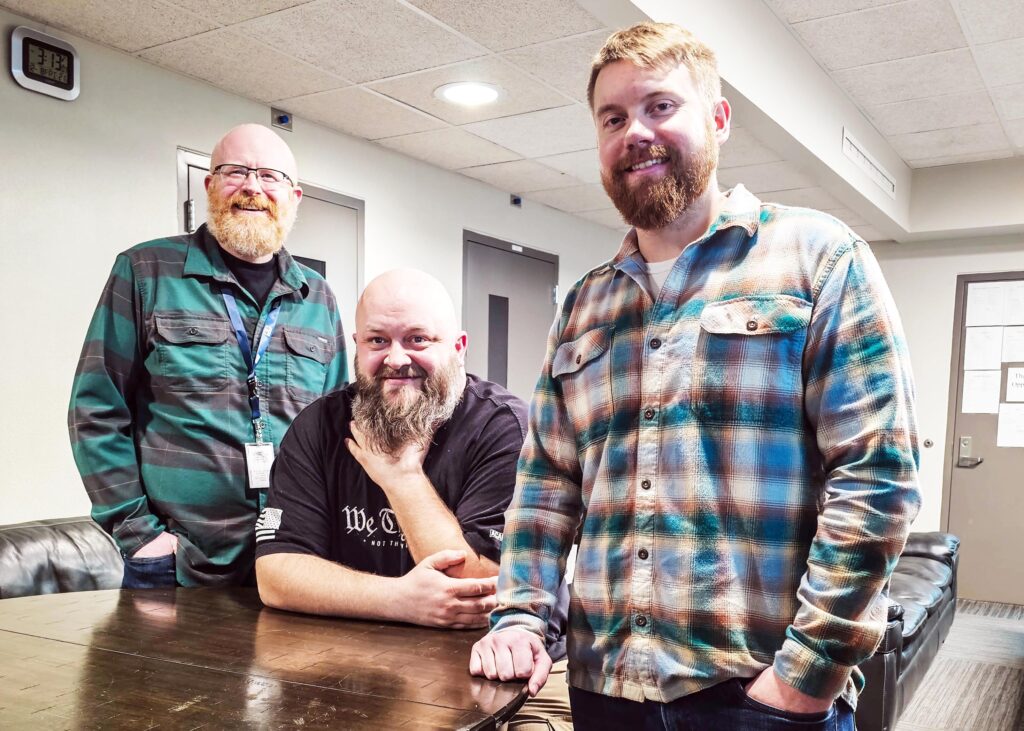
The administrators of the West Central Regional Juvenile Center have long tenure at the facility — (from left) facility director Josh Swanson, 10 years; superintendent James O’Donnell, 15 years; and program coordinator Jake Baumgartner, 12 years. (Photo/Nancy Hanson.)
Nancy Edmonds Hanson
When troubled youth have nowhere else to go in Minnesota, the West Central Regional Juvenile Center offers one of the few alternatives for helping them find their way.
Out on the street, the Juvenile Center – located to the west of the Family Service Center at 715 11th St. N. – is often referred to as “juvie,” The larger side of the center provides secure residential facilities for teen men and women sentenced by the court for criminal offenses.
Operated by a cooperative service agreement of Clay and nine other Minnesota countiesm as well as Cass in North Dakota, it provides education and counseling for those serving out their sentences, usually of 60 to 90 days. While the majority of its residents are male, the number of young women sentenced to the center has been rising dramatically in recent years. They now account for about 40% of the population, mirroring a statewide trend.
The other, non-secure side of the center, though, is a different story. “We provide non-secure emergency placement for both delinquent and non-delinquent youth,” explains Superintendent James O’Donnell, who has headed the facility since 2018. “We’re always full.”
Unlike the secure side of the Juvenile Center, the unsecured residential program is specifically for Clay County teens. About two dozen reside there at a time, compared to 42 to 45 on the secure side.
A majority of the teens who enter the non-secure program are delivered to the center’s doors by county social workers assigned to troubled families. Many, perhaps most, come from traumatic situations at home or on the streets. Many of the 12,000 brought there each year may remain only briefly, retrieved by a parent or guardian or released by social services personnel. Others, though, may remain longer; if for more than 72 hours, they’ll be seen by a judge. If treatment is recommended, they may reside at the center for as long as a year.
Aggressiveness is the common thread that brings them there. Almost all of the young people have suffered from ACE – adverse childhood experiences. They have experienced physical, sexual and emotional abuse. They’ve witnessed drug and alcohol abuse. They’ve been neglected and had a significant lack of permanence. About half of those in non-secure placement, O’Donnell estimates, fall on the autism spectrum.
And another thing connects these troubled young people: They have nowhere else to go for help.
“No one else will take them,” the superintendent explains. “No psychiatric hospitals or treatment programs will admit them due to their aggressiveness. Group homes can’t take them because of the 245-D rule they must operate under, even if they’d be better served in that environment.
“They end up with us. We’ve morphed into upping our game,” program director Josh Swanson explains. “We’re fortunate that our county board of commissioners has seen the problem and understands how we need to meet these kids’ needs.”
O’Donnell adds, “That’s not the case around most of the rest of Minnesota.”
They spend their days in classrooms staffed by teachers from the Moorhead school system. Lakeland Mental Health and other professionals provide psychological, psychiatric and family counseling tailored to each resident’s needs. That can include trauma therapy and programming specialized for substance use disorder or sexual behavior.
As the incidence of autism-spectrum has risen, staff members have been receiving additional training in how to work with them effectively. “We’ve really been shifting gears,” O’Donnell acknowledges. “This facility was designed for short-term placement, not longer-term, and if the youth have sensory issues, it is even more difficult. It takes a lot of additional resources to provide one-on-one attention for a kid in need.”
“Our program is person-centered, unique to each young person’s situation,” Swanson explains. “It’s highly flexible. We deal with some pretty complex cases.”
The secure side of the Juvenile Center works with twice as many young people at a time. The joint program was worked out in 2018 when the 12 member counties signed a 20-year commitment to operate the region’s secure program here in Moorhead. Only about half of Minnesota counties have contracts with similar facilities, including others in Anoka, Beltrami, Dakota and St. Louis counties.
Each west central county pays for services and accommodations for the teens who are sentenced to the Juvenile Center. The largest segments of its population come from Clay or Cass counties, each accounting for about 25% of the whole. The more rural areas send smaller numbers, perhaps another quarter in all.
The final fourth are admitted from non-member counties all across the state, highlighting the acute lack of options for delinquent youth. One admission this year was from Winona County in southeastern Minnesota. “They’re closer to Chicago than to Moorhead,” O’Donnell observes. Clay County benefits from these out-of-the-area placements, since those counties are charged substantially more than the partners. He estimates that revenue makes about one-third of the $900,000 Clay appropriates as its annual share.
“Minnesota is in a crisis when it comes to having safe and professionally staffed placement options for aggressive youth,” O’Donnell asserts. “The pressures to close correctional programs were spreading across the state and nation, and many programs in Minnesota did indeed close down. Currently there are no options at all for the counties that don’t have contracts with a juvenile facility like ours. Remodeling and expanding the WCRJC five years ago was a very smart and forward-looking move by the county commissioners.”
But the young men and women placed at the Juvenile Center benefit most from the collaboration. “We see lots of youth who don’t want to be here, of course, but they are comfortable here,” Swanson observes. “They are safe. They are among people who respond with compassion and who are willing to help them work through their issues.
“There are less and less places with the resources to work with these kids. We are becoming, more and more, their only option.”


